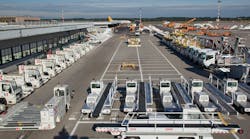It is projected that global airline passenger traffic will hit 7.2 billion travelers by 2035 according to the International Air Transport Association. To minimize landside congestion, major infrastructure improvements need to be made to maintain efficiency and innovation for passengers and cargo. Airports Council International – North America estimates that member airports would need to invest an additional $99.9 billion in the next four years to be able to stay ahead of projected growth. Although the majority of the costs are attributed to terminal expansion and improvements, transportation to and within the airport complex remains one of the biggest challenges when it comes to streamlining the experience for passengers, according to a recent American THINKS survey from HNTB Corporation.
The challenge is threefold: balance the needs of passengers getting to and from terminals, as well as from rental car facilities, offsite parking and public transportation; accommodate transportation plans under existing land constraints; and find the funding to pay for these necessary investments. Already airports across the country are implementing new multimodal transportation options, or have built transit goals into their master plans. Integrating airport access into city planning is an important connection that requires significant planning.
One of the most promising advancements in airport transportation is automated people movers, or APMs. Operating on specific heavily traveled routes within and just outside the airport property, these automated, driverless trains can accommodate up to 200 passengers and travel through constrained areas on elevated guideways. They help alleviate traffic on roadways, reduce emissions, and provide reliable, punctual service. APMs have already been put in service at Denver International Airport, San Francisco International, Chicago-O’Hare, Newark Liberty, Phoenix Sky Harbor and Hartsfield-Jackson Atlanta, with connections to regional transit systems. Additionally, three major airports will launch APMs in the next decade: Los Angeles International, Orlando International and Tampa International.
Increasing revenue is an important factor in driving and sustaining aviation infrastructure progress and development. Enhanced efficiency benefits both the economy and the individual users of the improvements. Multimodal transportation facilities can also link to revenue streams by offering retail, food, beverage options and connect to additional fee-based convenience services.
Bringing APMs into service requires substantial research and planning to ensure success. Appropriate feasibility studies and cost-benefit analyses should be conducted to ensure an APM is the right fit for the needs of the specific airport. There must be an efficient connection to off airport facilities, such as consolidated rental car hubs, public transportation, hotels, and dining venues. Finally, APMs should be considered as a major component of the overall airport master plan, and take into account increased future demand as passenger traffic grows.
Airports need to keep in mind how rapidly advancing new technology can alter the face of an industry. In contrast, infrastructure change is relatively slow. To remain competitive, airport master plans should be flexible to allow for the assimilation of new technologies, such as autonomous roadway bus-train systems that eliminate the costs for tracks, signaling and maintenance facilities linked to a track system. Soon, passengers may schedule a personal driverless car to get to and from the airport, which will shift infrastructure priorities from on and offsite parking facilities to developing larger vehicle staging areas.
As risks are mitigated, technology improves and increased passenger confidence is achieved, airports may need to modify infrastructure to accommodate future travel demand. An airport’s ability to be flexible and innovative with capital planning can deliver an efficient multimodal surface-moving experience for passengers, now and for the future.
Tom Rossbach is the national aviation architecture leader for HNTB Corporation. He provides strategic direction for projects within the national aviation market and has nearly 30 years of terminal planning and design experience. Contact Tom Rossbach at (312) 446-1800 or [email protected].


